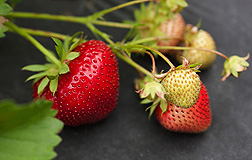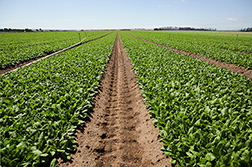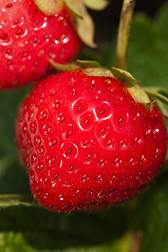New Tests Count Total Phenolics in Fruits and Veggies
Agricultural Research Service investigators have a long history of designing and developing reliable analytical methods for measuring nutrients and other compounds in foods. ARS scientists have now devised new analytical methods for detecting and measuring concentrations of phytochemicals called “polyphenols” in plant materials.
The class of health-promoting compounds is found in certain foods and beverages and is also referred to as “phenolics.” At the ARS Eastern Regional Research Center (ERRC) in Wyndmoor, Pennsylvania, scientists first reported on the new test and used it on a variety of samples of beverages, such as teas and juices; grains, such as rice and quinoa; and flaxseed.
In the laboratory, the scientists used the new method to measure the amount of phenolics in the various food samples by mixing them with Fast Blue BB diazonium salt. Under alkaline conditions, diazonium salt specifically couples with phenolics to form stable complexes that can be directly measured.
When compared to results using a traditional method to assess phenolic concentrations, the new Fast Blue BB method assessed higher amounts of total phenolics in most of the beverage and grain samples tested, and lower amounts in flaxseed and some juice blends tested. The results suggested the traditional method does not assess or pick up all phenolics present in samples tested and inadvertently measures other compounds besides phenolics.
The Fast Blue BB diazonium salt approach is relatively simple, inexpensive, and fast. A study describing the new method was published in the Journal of Agricultural and Food Chemistry in 2011.
|
|
Removing Interference
A later ARS study conducted at the Henry A. Wallace Beltsville [Maryland] Agricultural Research Center (BARC) further explored assessing total phenolics using Fast Blue BB. This study was performed on strawberries and was headed by plant physiologist Gene Lester with ARS colleagues at BARC and ERRC. They demonstrated that the Fast Blue BB assay provides a higher and more accurate estimate of total phenolics than the traditional assay, called Folin-Ciocalteu, or FC, that has been used for decades. FC uses a reducing reagent that detects phenolics indirectly and lacks the ability to be specific, or screen, for measuring phenolics alone, according to the scientists.
In the study, the researchers used the FC and Fast Blue BB tests to analyze total phenolic concentrations in five different genotypes of strawberry fruit that are commonly grown in the United States. Strawberries are an important source of phytochemicals, in particular phenolics. The team then compared the results of both tests.
The team found that the traditional FC test interacted with vitamin C (ascorbic acid) and sugars that are abundant in strawberry, which alters the accuracy of the assessment of phenolics. That means the FC method picks up other compounds in the plant itself and also in the media used. These additionally measured compounds are referred to as “interfering substances,” and they include fructose, glucose, and sucrose and other organic compounds naturally found in the extraction media. There are upwards of 50 interfering substances that impede an accurate measure of the types and amounts of phenolics when using the FC assay method to test for total phenolics.
|
|
During the study, the researchers also measured each known FC assay-interfering substance, including vitamin C and the fruit sugars, within the five genotypes of strawberries. They wanted to determine the effect of these interfering substances on the accuracy of the two assays for measuring total phenolics.
The FC method had a significant correlation with vitamin C, meaning it assessed vitamin C as phenolics, and was found to underreport or fail to assess total plant phenolics by nearly threefold. The FC method does not include a step to correct for picking up the interfering substances that are counted among total phenolics, according to the scientists. The researchers concluded that previous studies measuring the phenolics in strawberry fruit by use of the FC assay have greatly underestimated the amount of the fruit’s total phenolic concentrations.
Significantly, the new Fast Blue BB method had no interaction with vitamin C or with the other interfering substances. “Because Fast Blue BB is a direct assay, it only targets phenolic compounds, whereas Folin-Ciocalteu is an indirect assay—you can get false positives, primarily by picking up ascorbic acid and other substances,” says Lester.
The study was published in the Journal of Food Composition and Analysis in 2012.
Fast Blue BB Goes Green
While the Fast Blue BB method as originally developed at the ERRC was aimed to measure phenolics only in plant tissue that does not contain chlorophyll, the BARC researchers reasoned that the test should also work with green vegetables if modified. Lester led a study to gauge how summer and winter weather conditions affect levels of specific nutrients and compounds, including phenolics, in spinach. For the study, he and colleagues modified the Fast Blue BB assay so it could be used to test green plant material.
“Chlorophyll absorbs at the same wavelength as the Fast Blue BB,” says Lester. “We developed a simple, rapid, chlorophyll-removal step that eliminates this confounding factor in the original assay so that the method could be used to assess green plant tissues.”
The scientists used the modified method to gauge the amount of total phenolics in different spinach cultivars grown under different production conditions. “We showed the Fast Blue BB can now be used universally to accurately assess total phenolics for all fruit and vegetable plant tissues,” says Lester. The study was published in the Journal of Agricultural and Food Chemistry in 2013.—By Rosalie Marion Bliss, Agricultural Research Service Information Staff.
This research is part of Quality and Utilization of Agricultural Products, an ARS national program (#306) described at www.nps.ars.usda.gov.
Gene E. Lester is with the USDA-ARS Office of National Programs, 5601 Sunnyside Ave., Beltsville, MD 20705-5138; (301) 504-4616.
"New Tests Count Total Phenolics in Fruits and Veggies" was published in the November/December 2014 issue of Agricultural Research magazine.










